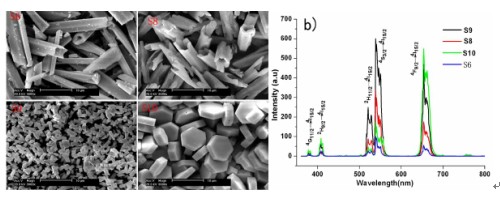| [1] Vennerberg, D.; Lin, Z. Q. Sci. Adv. Mater. 2011, 3, 26.[2] Wang, F.; Liu, X. G. Chem. Soc. Rev. 2009, 38, 976.[3] Li, C.; Lin, J. J. Mater. Chem. 2010, 20, 6831.[4] Auzel, F. Chem. Rev. 2004, 104, 139.[5] Li, T. G.; Liu, S. W.; Zhang, H. P.; Wang, E. H.; Song, L. J.; Wang, P. J. Mater. Sci. 2011, 46, 2882.[6] Chatterjee, D. K.; Gnanasammandhan, M. K.; Zhang, Y. Small 2010, 6, 2781.[7] Chen, W. J. Nanosci. Nanotechnol. 2008, 8, 1019.[8] Bechet, D.; Couleaud, P.; Frochot, C.; Viriot, M. L.; Guillemin, F.; Barberi-Heyob, M. Trends Biotechnol. 2008, 26, 612.[9] Achatz, D. E.; Ali, R.; Wolfbeis, O. S. Lumin. Appl. Sensor Sci. (Luminescence Applied in Sensor Science) 2011, 300, 29.[10] Buenzli, J.-C. G.; Eliseeva, S. V. J. Rare Earth. 2010, 28, 824.[11] Li, Z. Q.; Li, X. D.; Liu, Q. Q.; Chen, X. H.; Sun, Z.; Liu, C.; Ye, X. J.; Huang, S. M. Nanotechnology 2012, 23, 025402.[12] Zhang, C.; Sun, L.; Zhang, Y.; Yan, C. J. Rare Earth. 2010, 28, 807.[13] Ghosh, P.; Oliva, J.; De la Rosa, E.; Haldar, K. K.; Solis, D.; Patra, A. J. Phys. Chem. C 2008, 112, 9650.[14] Li, Z. Q.; Zhang, Y.; Jiang, S. Adv. Mater. 2008, 20, 4765.[15] Mai, H. X.; Zhang, Y. W.; Sun, L. D.; Yan, C. R. J. Phys. Chem. C 2007, 111, 13730.[16] Priyam, A.; Idris, N. M.; Zhang, Y. J. Mater. Chem. 2012, 22, 960.[17] Kim, W. J.; Nyk, M.; Prasad, P. N. Nanotechnology 2009, 20, 185301.[18] Li, C.; Quan, Z.; Yang, J.; Yang, P.; Lin, J. Inorg. Chem. 2007, 46(16), 6329.[19] Tian, G.; Gu, Z. J.; Zhou, L. J.; Yin, W. Y.; Liu, X. X.; Yan, L.; Jin, S.; Ren, W. L.; Xing, G. M.; Li, S. J.; Zhao, Y. L. Adv. Mater. 2012, 24, 1226.[20] Huang, Q.; Yu, J.; Ma, E.; Lin, K. J. Phys. Chem. C 2010, 114, 4719.[21] Huang, M.; Meng, F.; Yuan, X.; Li, Y.; Liu, R. Luminescence 2008, 23, 73.[22] Suyver, J. F.; Aebischer, A.; Biner, D.; Gerner, P.; Grimm, J.; Heer, S.; Kramer, K. W.; Reinhard, C.; Gudel, H. U. Opt. Mater. 2005, 27, 1111.[23] Li, C.; Yang, J.; Quan, Z.; Yang, P.; Kong, D.; Lin, J. Chem. Mater. 2007, 19(20), 4933.[24] Li, C.; Yang, J.; Yang, P.; Lian, H.; Lin, J. Chem. Mater. 2008, 20(13), 4317.[25] Zhao, J. W.; Sun, Y. J.; Kong, X. G.; Tian, L. J.; Wang, Y.; Tu, L. P.; Zhao, J. L.; Zhang, H. J. Phys. Chem. B 2008, 112, 15666. |
